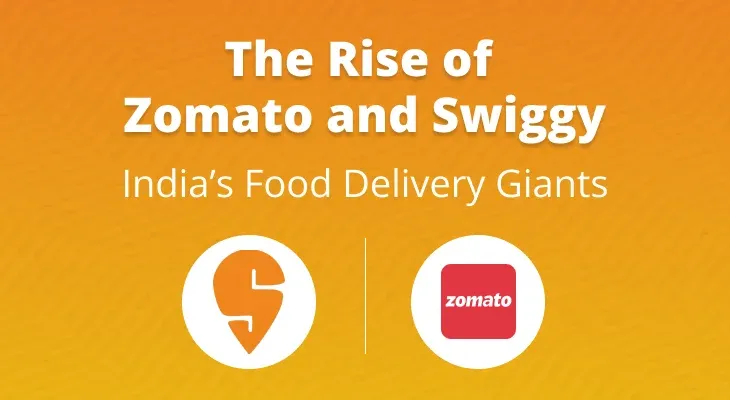
Table of content
- The Birth of Zomato: A Bold Move in Restaurant Discovery
- Key Milestones in Zomato's Journey
- Swiggy: Rising to the Challenge
- Key Milestones in Swiggy’s Journey
- Zomato vs Swiggy: The Numbers Behind the Competition
- Quick Commerce: The New Frontier
- Competition and Strategy: Innovations in a Tight Market
- The Future: What Lies Ahead?
- Final Thoughts
The Rise of Zomato and Swiggy: India’s Food Delivery Giants
Remember the days when dining out with family was a well-planned, occasion-based event? Those were different times, not too long ago, before food delivery apps like Zomato and Swiggy transformed how we experience dining. Now, with just a few taps, your favourite meals can arrive right at your doorstep. But how did these platforms grow to dominate the Indian food-tech industry? Let’s dive into the journeys of Zomato and Swiggy, two companies that reshaped India’s food delivery landscape.
The Birth of Zomato: A Bold Move in Restaurant Discovery
In 2014, Deepinder Goyal and Pankaj Chaddah, based in Delhi NCR, noticed a gap in the restaurant marketing space. Traditionally, restaurants distributed their menus via newspapers, hoping they’d reach potential customers. This approach, however, came with several issues — menus often got lost or discarded, and it was challenging to build trust with customers who were unfamiliar with these eateries. Recognising this opportunity, Goyal and Chaddah launched FoodieBay, an online directory where users could browse restaurant menus, contact details, and share reviews of their dining experiences.
Within nine months, FoodieBay became the largest restaurant directory in Delhi NCR, and two years later, it rebranded as Zomato, marking the start of its rapid ascent.
Key Milestones in Zomato's Journey
After its successful rebranding, Zomato quickly diversified its services. Here’s a look at some key milestones that defined Zomato’s growth:
2015: Launched restaurant reservations, allowing customers to book tables directly through the app.
2017: Rolled out Zomato Gold, a subscription service offering discounts and benefits, and acquired logistics company Runnr, setting the foundation for Zomato’s food delivery services.
2018: Entered the groceries market with HyperPure, a platform providing high-quality ingredients to partner restaurants.
2019: Organised Zomaland, a food carnival, creating a unique brand experience.
2020: Adapted to the pandemic by introducing contactless dining.
2021: Made history as India’s first food tech brand to go public.
2022: Acquired Blinkit to expand into quick commerce, delivering essentials in under 10 minutes.
2024: Expanded further with the acquisition of Paytm’s ticketing business, while Deepinder Goyal launched Continue, focusing on health tracking and mental wellness.
Today, Zomato stands as a robust platform, blending food delivery, dining experiences, and quick commerce under one umbrella.
Swiggy: Rising to the Challenge
Around the same time, in 2014, another major player was emerging in the crowded Koramangala area of Bangalore — Swiggy. Founded by Sriharsha Majety, Nandan Reddy, and Rahul Jaimini, Swiggy started small, with just six delivery executives and a roster of 20 restaurants. Despite these modest beginnings, Swiggy soon carved out a unique identity in the Indian food delivery market.
Key Milestones in Swiggy’s Journey
Swiggy’s innovative approach and strategic expansions allowed it to stand shoulder-to-shoulder with Zomato. Here’s a glance at some major events in Swiggy’s growth story:
2014: Launched operations with just 35 daily orders.
2015: Secured its first funding round, receiving $2 million.
2017: Introduced Access Kitchens, a network of ready-to-occupy kitchens that helped restaurants scale.
2018: Became India’s fastest-growing food-tech unicorn, marking its status in the market.
2019: Launched Swiggy Genie, a pickup and drop service, and expanded from 100 to 500 cities.
2020: Expanded into quick commerce with Swiggy Instamart, a grocery delivery service.
2022: Acquired Dineout in a $ 120 million stock deal, expanding its dining-out offerings.
2024: Announced its IPO, making it one of India’s most anticipated public offerings.
Swiggy’s quick commerce and delivery innovation have solidified its standing, giving it a competitive edge and making it one of the most anticipated IPOs of 2024.
Zomato vs Swiggy: The Numbers Behind the Competition
Today, Zomato and Swiggy are neck-and-neck, competing for the top spot in the Indian food delivery market. Here’s how their financials stack up:
Metric | Swiggy (FY24) | Zomato (FY24) |
|---|---|---|
| Revenue (₹ crore) | 11,247 | 12,114 |
| Net Profit (₹ crore) | -2,350 | 351 |
| Gross Order Value (₹ crore) | 24,717 | 32,224 |
| Average Order Value (₹) | 428 | 428 |
| Monthly Transacting Users (crore) | 1.27 | 18.4 |
| Restaurant Partners | 1.97 lakh | 2.47 lakh |
| Cities Present | 653 | 800+ |
Despite their similarities in services, Zomato and Swiggy’s approaches to growth have led to subtle differences. Zomato’s larger user base and profitability indicate a current lead, but Swiggy’s steady innovation and expansion reflect strong potential.
Quick Commerce: The New Frontier
Both Zomato and Swiggy have ventured into quick commerce — Zomato with Blinkit and Swiggy with Instamart. Here’s how they compare in this emerging sector:
Metric | Instamart | Blinkit |
|---|---|---|
| Revenue (₹ crore) | 979 | 2,301 |
| Gross Order Value (₹ crore) | 8,086 | 12,469 |
| Average Order Value (₹) | 460 | 613 |
| Monthly Transacting Users | 42.4 lakh | 51 lakh |
| Dark Stores | 523 | 526 |
| Cities Present | 27 | 26 |
Quick commerce aligns with changing consumer expectations for fast service, especially in groceries and essentials. With quick commerce forecasted to grow, Zomato and Swiggy’s investments in Blinkit and Instamart could become significant revenue drivers.
Competition and Strategy: Innovations in a Tight Market
Zomato and Swiggy continue to diversify and innovate to maintain relevance in a highly competitive market. Zomato’s acquisitions of Blinkit and Paytm’s ticketing business have broadened its offerings. Meanwhile, Swiggy’s acquisitions of Dineout and its IPO plans mark a strategic focus on both digital dining experiences and market expansion.
Both brands are also exploring new ways to provide value to customers, such as Swiggy’s subscription plans for free delivery and Zomato Gold’s exclusive benefits. Their shared commitment to quick commerce reflects a mutual understanding of the value of speed and convenience.
The Future: What Lies Ahead?
With Zomato’s shares rallying since listing and Swiggy preparing for a highly anticipated IPO, investors are keenly watching to see if Swiggy’s IPO will match or exceed Zomato’s success. The food delivery market in India, with its vast consumer base and evolving digital preferences, promises further growth for both companies.
For investors, both Zomato and Swiggy present exciting opportunities, each with a unique set of strategies and growth drivers. Only time will tell how these brands continue to innovate and shape India’s digital food landscape.
Final Thoughts
The rise of Zomato and Swiggy reflects not just a transformation in India’s food delivery scene, but a broader trend of convenience-focused digital services catering to India’s growing tech-savvy consumer base. Both brands have thrived by continually evolving and meeting market demands, whether through restaurant discovery, quick commerce, or customer-centric services. As they venture into new arenas and compete neck-to-neck, their stories underscore the incredible potential of India’s food-tech sector — an opportunity both customers and investors are eager to explore.


